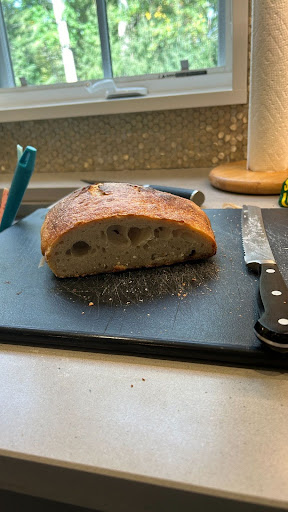
When I was younger, all I wanted was to get my backbend kick over. Without any prior gymnastics training, I decided I could do it. I would stand in the same spot in my living room and fall on my head over and over, till I saw stars floating above me. I failed, and failed and failed until one day I didn’t. One day, I randomly kicked over and landed on my feet. It was not pretty, it was not even good, but I had done it. My mom celebrated with me from the kitchen and humored my new found confidence. Then I went right back to it. Over, and over and over like a dizzying video playing on loop. For months I fell on my knees, head and neck. Eventually, my skill became consistent.
My sourdough journey has mirrored this persistence. On a random September Saturday morning, I impossibly decided to start a sourdough starter. I watched one tutorial on Tik Tok, and went for it. I mixed equal parts flour to water in a mason jar and set it on my counter. For the next two weeks I fed my starter, waiting for something to happen. Very little did. There were no bubbles and no growth, meaning my sourdough was not alive. Until one day it was. I woke up to the shock of a bubbly, smelly, doubled starter. In my excitement, I named it Greg. Don’t ask me why, it just felt right. Sourdough starter takes about three weeks to be fully devolved and be ready to bake with. As an impatient person, that next week felt like years.
I was so excited to make my first loaf, I watched and read every tutorial I could find. Overconfident, I followed a recipe and made my first Sourdough loaf, if you can even call it that. My “loaf” was more of a hockey puck. Flat and dense, with a sticky gummy texture. For the next month, I made about a dozen hockey pucks. I thought Greg was failing me. I was about to give up and use yeast, when I figured out what a bulk ferment is.
Bulk ferment is the most important part of the sourdough fermentation. You leave the dough for 6-10 hours to rise, and for the yeast to react. It is what gives bread a light crumb and texture. I had only been giving my dough about three hours to bulk ferment which was causing my loafs to come out dense. My next loaf, I let the dough rise on the counter overnight and to my surprise I had a bubbly dough like the videos I had seen. That October Saturday, I made my first edible loaf of sourdough. Edible, not perfect.
By thanksgiving, Greg and his loaves were strong enough to share with my friends and family. I had developed a rhythm with my sourdough. I fed equal Greg parts water and flour on Monday, Wednesday and Friday afternoon. I made a dough every Friday night and baked it off on Saturday, Sunday or even Wednesday if I wanted my loaf to be nice and sour. With every loaf I learned something new, and found what worked best for me. I learned that adding a lot of salt during the second set stretches and folds allows the dough to hold its shape, and if you add sugar into the first set of folds it will promote fermentation and will give your bread a nice sour flavor.

One of the best things about sourdough is that you get to share it with others. Not only do I share my loaves, I also share parts of Greg with friends and I get to help them start their sourdough journey. I have begun experimenting with my starter and making other recipes such as croissants, crackers, granola, muffins, scones and more. Sourdough is how I use some of my creativity, and challenge myself. I am still on my sourdough journey, and continue to fall on my head once and a while.













































